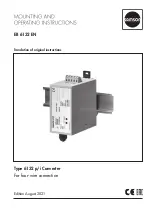
Network Audio Playback
®
4826 Sterling Drive, Boulder, CO 80301
PH: 720.406.8946 | [email protected] | www.psaudio.com
15-042-21-1 Rev A
Instruction i
©2010 PS Audio International Inc. All rights reserved.
The Bridge
The PWD can become far more than a high-performance stereo
DAC. An optional network Bridge can be added that connects
the PWD to any home network. The Bridge allows playback
data from a source not directly connected to the PWD.
The network Bridge incorporates the exact same Digital LensTM
technology found in the PWT – without the input to the Lens
being from a connected source. Instead, the input to the internal
Lens of the Bridge is over a network: addressable through an
Ethernet connection. Music stored on a hard drive or even an
Internet radio service are all accessible via this network Bridge.
Once installed, the Bridge will be accessed as another input.
There will be no quality or performance issues on the Bridge
for the same reason as the PWT: the built in Digital Lens and
output asynchronous clocks of both devices ensure bit-perfect
performance.
The Bridge slips right into the slot on the back of the PWD and
can be added in less than 30 seconds by the owner. Simply
remove the rear cover plate, insert the Bridge and you are done.
The front panel touch screen software will be updated at the
same time as the Bridge installation allowing full access to
music stored on a Network Attached Storage Device (NAS hard
drive).
The Bridge is currently available from any authorized PS Audio
dealer, distributor or integrator.
Introduction to a Network Audio System
In any digital audio system there are three central requirements:
1. A place – storage – for the digital audio data
2. A player
3. A controller
In the original digital audio system (a CD player), the source
data was stored on an optical disc called a CD, the player (an
optical disc reader and a DAC) were built into the CD player, and
the control functions were handled with either the player’s front
panel or a hand-held remote control.
In a computer-based digital audio system, a hard drive or flash
memory takes the place of the CD. Reading the stored audio
information requires a special program to interpret the files as
an audio signal. Often this program resides on the computer,
but can also live in a device attached to the computer via a
USB or Firewire cable. Control is usually handled through the
computer’s video screen, a keyboard and a mouse.
In a network digital audio system there are a many more options
for storage, including (but not limited to) a computer, an external
drive, and even the Internet itself. The player (or players)
can be connected to the audio source throughout the home
and controller options may range from a computer, to remote
devices such as webpages, wireless handheld touch screens,
and smart phones.
The network audio approach offers the best choice for
delivering music throughout the home. Using the PerfectWave
DAC and Bridge ensures there are no limitations to quality,
performance, format, or resolution of the recorded audio.
Let’s take a closer look at the basic network audio system
requirements for connecting your PS Audio Bridge to music.
The PerfectWave Network
In the PS Audio PerfectWave Network Audio system there are
four central requirements:
1. A Network to stream the media between the source and the
player (based on a router)
2. A Controller (typically an Apple iDevice like the iPod, iPad,
or iPhone running PS Audio’s tagNplay app available from the
iTunes app store)
3. A place – storage – for the digital audio data (computer, NAS)
4. A player (this is the PWD and Bridge)
In the PS PerfectWave system, the piece of equipment that ties
all four of the above-required components together is the home
network router. Here is what a typical system looks like.
The PS Audio network based high-resolution audio system has
its roots in something called UPnP or Universal Plug and Play.
UPnP is really nothing more than a way for network equipment
to talk to one another. The beauty of UPnP is everything is
enabled with no setup.
Owner’s Reference
Perfect Wave DAC











































